![]()
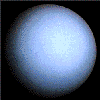 Uranus Uranus
was discovered by William Hershel in 1781
Uranus Uranus
was discovered by William Hershel in 1781![]()
Diameter (km)........................................51118
Mean density (g/cm^3) ...............................1.290
Escape velocity (km/sec)..............................21.300
Average distance from Sun (AU).......................19.18
Rotation period (length of day in Earth hours).......17.9
Revolution period (length of year in Earth years)....84
Obliquity (tilt of axis in degrees)..................97.9
Mean temperature (K).................................59
Atmospheric components...............................83% hydrogen,
15% helium,
2% methane (at depth)
Rings................................................Uranus has
a system of narrow, faint rings. Ring particles are dark,
and could consist of rocky or carbonaceous material.
![]()

The greenish color of Uranus' atmosphere is due to methane and high-altitude photochemical smog. Voyager 2 acquired this view of the seventh planet while departing the Uranian system in late January 1986. This image looks at the planet approximately along its rotational pole.
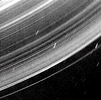
This image reveals many broad lanes of dust surrounding the 9 main rings of Uranus. It was taken by Voyager 2 looking back toward the sun through the ring system. The dust is especially bright in this view, for the same reason that we can see dust on a windshield better when we are driving toward the sun. The rings of Uranus are actually very dark. The short stubby streaks are stars slightly smeared during the long exposure.
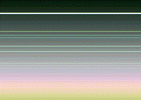
The 9 main rings of Uranus are visible here as horizontal lines. The somewhat fainter, pastel lines seen between the rings are artifacts of computer enhancement. Six narrow-angle images were used to extract color information from the extremely dark and faint rings. The final image was made from three color averages and represents an enhanced, false-color view. The image shows that the brightest, or epsilon ring at top is neutral in color, with the fainter 8 remaining rings showing slight color differences between them.
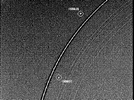
The discovery of two "shepherd" satellites has advanced our understanding of the structure of the Uranian rings. The moons, designated 1986U7 (Cordelia) and 1986U8 (Ophelia), are seen here on either side of the bright epsilon ring and are believed to confine it by their gravitational effects. Inward from the epsilon ring are the delta, gamma, eta, beta and alpha rings. The 4, 5, and 6 rings are barely visible inward from there. The rings have been studied since their discovery in 1977. The epsilon ring appears surrounded by a dark band as a result of the image processing.

Miranda is the innermost of the large Uranian satellites. Its surface is composed mostly of rolling cratered plains that probably date back to the early evolution of the solar system when impact rates were extremely high. Half of Miranda's surface is younger based on the fewer number of craters; it consists of complex sets of parallel and intersecting scarps and ridges. The bright V-shaped feature in the grooved area is Inverness Corona, and has been nicknamed the "Chevron". The huge, jagged canyon on the right limb is in the direction of Uranus itself.

The images which make up this mosaic of Miranda are among the highest resolution pictures that Voyager obtained of any of the new worlds it encountered during its mission. On Miranda, ridges and valleys of one province are cut off against the boundary of another. Probable compressional folded ridges are seen in arcuate patterns, as are many extensional faults. Some of these show large scarps ranging from 0.5 - 5 km (0.3 - 3 mi) in height -- higher than the walls of the Grand Canyon on Earth.
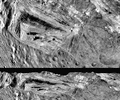
The Chevron is an unusual feature on the surface of Miranda. The small number of craters indicates that this extensive system of faults is younger than the surrounding heavily cratered terrain. Some of the dark material inside the Chevron may be igneous material ejected along the fault planes. The lower image offers a perspective view of the same region shown in the top. It was generated from a computer model of the surface topography. The relief is exaggerated by about 50- fold; the view angle is about 15 degrees above the horizon.

Miranda displays a dramatically varied surface. Easy to see in this 660m- (2160 ft-) wide image are numerous ridges and valleys -- a topography that was probably produced by compressional tectonics. Cutting across Miranda's ridges and valleys are many faults. The largest fault scarp is seen below and right of center; it shows grooves probably made by the fault blocks as they rubbed against each other (leaving what are known as slickensides). Movement of the down-dropped block is shown by the offset of the ridges. The fault may be 5 km (3 mi) high, or higher than the walls of the Grand Canyon on Earth.
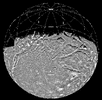 Partial Mosaic
Partial MosaicThe second large satellite of Uranus reveals a complex geologic history. Global fracturing coupled with the eruption of icy volcanic fluids (as cold as 175 K) have marred its surface. The original Voyager images were projected onto a sphere to provide this unique view of Ariel.
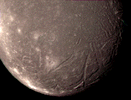
The complex terrain of Ariel is captured in this view of its southern hemisphere. Most of the surface consists of intensely cratered terrain transected by fault scarps and graben. Some of the largest graben, which can be seen near the terminator (at right), are partly filled with younger deposits that are less heavily cratered. Bright spots near the limb and toward the left are chiefly the rims of craters. Most of the brightly rimmed craters are too small to be resolved here, although one crater about 30 km (20 mi) in diameter is easy to spot near the center.

The abundance of impact craters and prominent global tectonic features on Titania are obvious in this image. The large fault valleys are some 1500 km (930 mi) long and 75 km (47 mi) wide. Near the bottom of the image the valley Messina Chasmata cuts through the impact crater Ursula (200 km or 124 mi in diameter). This high-resolution image was taken at a distance of 369,000 km (229,000 mi). Note that Titania's south pole is toward the left, since it rotates about Uranus' equator, approximately perpendicular to the ecliptic plane.
The surface of Titania has recorded many different types of geologic activity throughout its history. In addition to numerous impact scars, there is a large, trench-like feature near the terminator at middle right that suggests at least one episode of tectonics. A basin-like structure is visible near the upper right of the image. The neutral gray color of Titania is characteristic of all the Uranian satellites. Surface details about 9 km (6 mi) in size are visible. Titania has a diameter of 1600 km (1000 mi).
![]()